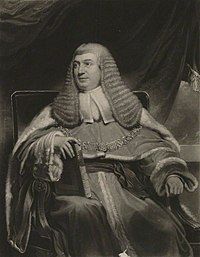
William Draper Best, 1st Baron Wynford, PC (13 December 1767 – 3 March 1845), was a British politician and judge. He served as Chief Justice of the Common Pleas from 1824 to 1829.
Background and education
Best was the third son of Thomas Best of Haselbury Plucknett in Somerset. He was educated at Crewkerne Grammar School and became a student at Wadham College, Oxford at the age of 15, but left at 17 without a degree. Originally destined for a career in the Church, he instead chose to study law, and entered the Middle Temple on 9 October 1784.
Legal career
| This section needs additional citations for verification. Please help improve this article by adding citations to reliable sources in this section. Unsourced material may be challenged and removed. Find sources: "William Best, 1st Baron Wynford" – news · newspapers · books · scholar · JSTOR (December 2022) (Learn how and when to remove this message) |
Best was Called to the Bar on 6 November 1789, and established a successful legal practice. In 1802, he was elected to parliament for Petersfield as a Whig, a seat he held until 1806. After joining the Tories, he sat for Bridport from 1812 to 1817 and then represented Guildford from 1818 to 1819.
In 1813, Best was appointed Solicitor-General to the Prince of Wales, where he remained until 1816. He was then Attorney-General to the Prince of Wales from 1816 to 1818 and Chief Justice of Chester in 1818. The following year he was made a Judge of the Common Pleas and knighted. Best was admitted to the Privy Council in 1824 and appointed Chief Justice of the Common Pleas, a position he held until 1829.
In the latter year Best was raised to the peerage of Baron Wynford, of Wynford Eagle in the County of Dorset.
Lord Wynford later served as a Deputy Speaker of the House of Lords. Despite his earlier affiliation with the Whigs, he became known as an ardent Tory, and vigorously opposed the Reform Act 1832 (2 & 3 Will. 4. c. 45). Lord Wynford suffered from gout for many years, and was carried into the House of Lords in an arm-chair, in which he was also allowed to address the rest of the house. However, he was later forced to retire from public life due to his illness.
Family
| This section does not cite any sources. Please help improve this section by adding citations to reliable sources. Unsourced material may be challenged and removed. Find sources: "William Best, 1st Baron Wynford" – news · newspapers · books · scholar · JSTOR (December 2022) (Learn how and when to remove this message) |
In 1794, Lord Wynford married Mary Anne, daughter of Jerome Knapp Jr. of Chilton in Berkshire (now Oxfordshire), Clerk of the Haberdashers' Company, by his second wife, Sarah, daughter and eventual heiress of George Noyes of Southcote, Berkshire, and Andover, Hampshire. They lived at Wynford House at Wynford Eagle, Dorset where they raised ten children. He died in March 1845, aged 77, and was succeeded in the barony by his eldest son, William Samuel Best. Lord Wynford's daughter, Grace Anne Best, married Philip Lake Godsal, the grandfather of Philip Thomas Godsal.
Arms
References
- "William Draper Best, 1st Baron Wynford - National Portrait Gallery". www.npg.org.uk. Retrieved 20 February 2024.
- "Crewkerne" in John Marius Wilson, Imperial Gazetteer of England and Wales (1870): "The grammar school was founded in 1499; has an endowed income of £320, with four exhibitions; and had for a pupil Mr. Justice Best, afterwards Lord Wyndford."
- "No. 18582". The London Gazette. 5 June 1829. p. 1030.
- Stephen, Leslie, ed. (1885). "Best, William Draper" . Dictionary of National Biography. Vol. 4. London: Smith, Elder & Co.
- Kidd, Charles, Williamson, David (editors). Debrett's Peerage and Baronetage (1990 edition). New York: St Martin's Press, 1990,
External links
- Hansard 1803–2005: contributions in Parliament by Lord Wynford
- Hutchinson, John (1902). "Best, William Draper" . A catalogue of notable Middle Templars, with brief biographical notices (1 ed.). Canterbury: the Honourable Society of the Middle Temple. p. 20.
| Parliament of the United Kingdom | ||
|---|---|---|
| Preceded bySir Samuel Hood, Bt Sir Evan Nepean, Bt |
Member of Parliament for Bridport 1808–1816 With: Sir Horace St Paul, Bt |
Succeeded byHenry Charles Sturt Sir Horace St Paul, Bt |
| Preceded byThomas Cranley Onslow Arthur Onslow |
Member of Parliament for Guildford 1818–1819 With: Arthur Onslow |
Succeeded byCharles Baring Wall Arthur Onslow |
| Legal offices | ||
| Preceded byThe Lord Gifford | Chief Justice of the Common Pleas 1824–1828 |
Succeeded bySir Nicholas Conyngham Tindal |
| Peerage of the United Kingdom | ||
| New creation | Baron Wynford 1829–1845 |
Succeeded byWilliam Samuel Best |
- 1767 births
- 1845 deaths
- Barons in the Peerage of the United Kingdom
- Peers of the United Kingdom created by George IV
- Chief justices of the Common Pleas
- Members of the Parliament of the United Kingdom for Bridport
- UK MPs 1807–1812
- UK MPs 1812–1818
- UK MPs 1818–1820
- UK MPs who were granted peerages
- Justices of the King's Bench
- Politicians from Dorset
- Members of the Privy Council of the United Kingdom
- Knights Bachelor

